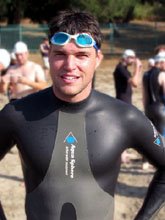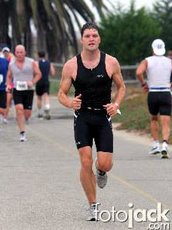Recently I joined the National Strength and Conditioning Association, which is the hoop-di-doo club for people who take this fitness thing a liiiitle bit too seriously. Like, well, ME. One of the perks of membership is that you receive a quarterly journal packed full of scientific articles with titles like "Effects of Electromyostimulation Training on Muscle Strength and Power of Elite Rugby Players." (Upshot: said effects? Good.)
For me, these articles fall somewhere along the fascinating-incomprehensible continuum; still, I have a fun time trying to figure out what they’re saying. Plus, I feel all smart and everything carrying a scientific journal around, even if most of the experiments involve things like making dozens of elite athletes hop repeatedly down a football field on one foot while holding brightly-colored Swiss balls over their heads. The articles are written in scientist-ese, naturally enough, but there’s a distinct whiff of "Revenge of the Nerds" between their lines of polished, objective prose. Which I personally find hilarious. As in
Doctor of Exercise Physiology #1: Well, Doctor, do you think we’ve proved conclusively that the propeller beanies and aerodynamic gold lame leggings don’t in fact aid in base-running speed in these high-level college athletes?
Doctor of Exercise Physiology #2: I remember some of these ball players from high school. They took my lunch money and shoved me in a locker. Let's keep the experiment going for the rest of the season.
I've managed to get through a few dozen of these articles, and what keeps coming up is essentially a reiteration of one of the first principles of physical training of any kind: specificity.
One of my first blog entries EVER was on the SAID principle, which is one of the most elegant theories in the field of exercise science: it states that the body Specifically Adapts to any Imposed Demand: practice holding your breath and you get better at holding your breath. Practice doing pushups and, yes, you’ll get better at pushups. I thought I had a pretty good grasp of this notion, but until I started delving into the scientific journals, I didn't quite have a grasp on just how specific those specific adaptations were.
Take, for instance, a study headed up by Eric Cressey (whose contributions to the field at a very young age I resent at length here). In "The Effects of Ten Weeks of Lower-Body Unstable Surface Training on Markers of Athletic Performance," Cressey and his colleagues take one of the most common exercise modalities that falls under the "functional" umbrella -- stability training -- and tests it in actual practice.
We've all seen stability devices in gyms over the last few years: Swiss Balls, Bosu Balls, wobble boards, Dyna-Discs, Nike "Core" Boards, and their kin, all of which are supposed to improve our balance, and thereby (it is often claimed), our ability to, say, walk or run on an uneven surface, or respond more quickly to changes in direction or speed during an athletic contest.
Stability training, Cressey points out, has proven effective in a rehabilitative context. The question he asks here is, will training on an unstable surface help a healthy athlete get even better?
Without getting into too much detail, the answer is a resounding 'no.' Comparing two groups of soccer players, one of which followed a standard stable strength and conditioning protocol and another of which used instability training, the stable-environment group left the instability trainees in the dust. The data suggest that training on an unstable surface might make an athlete less "springy" off a stable surface (Cressey writes that "Torque developed by the antagonists decreases net torque in the desired direction," but I'm pretty sure he means that they get less 'springy.")
The reason comes down to the good ol' SAID principle: since soccer matches are not held on unstable surfaces, and since players' feet are rarely fixed in place for even a second at a time, performing, say, lunges on an unstable surface, as the athletes in this study did, will have very little direct application on a soccer field (or on performance tests designed to gauge an athlete's performance on such a field).
Now, if I were to open up shop in Venice and the local gondolier squad came to me to help them put together their program, I'd point them in the direction of the unstable surface lunge before they could say "Ciao, bello." Their vocation demands that they keep their balance in all kinds of tricky positions on a long, narrow boat floating through choppy waters of the Grand Canal, with drunken tourists creating further testing their sea-legs by vomiting over the side at regular intervals.
But that's a pretty narrow demographic there, Freckles.
The question that studies like this can effectively answer is "is system x -- which is designed to help trainees with problem y -- a magic bullet that will benefit all of us in some mysterious way? Is system x the holy grail of training methods?"
And time and again the answer is no. The body adapts specifically.
The patently obvious but oft-ignored take-home point for the average Joe or Jane trainee is that behavior must align with goals. The simple question to ask is, "Does what I’m doing in the gym (and my diet, sleep habits, etc.) support my goals?" If your goal is "better athletic performance," and all you do is tricep kickbacks, the answer is no. If your goal is "fat loss" and you diet without exercising, the answer is no. If your goal is "better posture," and all you do is bench presses, you better believe the answer is no, and then go back and read "External Rotation for Fun and Profit," and this time, pay attention!
Want to know the ultimate secret of being a fitness coach? Here it is, folks:
HOW TO GET BETTER AT “X”:
1) Do “X.”
2) If you can’t do “X,” break down “X” into pieces you CAN do and practice those until you can do “X.”
3) Do “X.”
If you feel like reading a larger 'life application' into the the above principle, go right ahead...
Wednesday, August 01, 2007
Nerd Alert!
Subscribe to:
Post Comments (Atom)




No comments:
Post a Comment